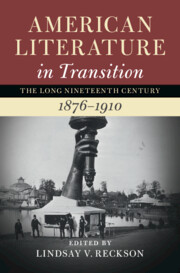Book contents
- American Literature in Transition, 1876–1910
- Nineteenth-Century American Literature in Transition
- American Literature in Transition, 1876–1910
- Copyright page
- Contents
- Contributors
- Series Preface
- Acknowledgments
- Chronology
- Introduction
- Part I Transitive States
- Part II Post-Reconstruction Aesthetics
- Part III Old Materialisms
- Part IV Immanent Techniques
- Chapter 15 Frances Harper’s Reconstruction
- Chapter 16 Emma Lazarus’s Cosmopolitanism
- Chapter 17 Henry James’s Temporalities
- Chapter 18 Charlotte Perkins Gilman’s Pragmatism
- Chapter 19 Nicholas Black Elk’s Cosmology (or, Post-Reconstructing Black Elk)
- Index
Chapter 15 - Frances Harper’s Reconstruction
from Part IV - Immanent Techniques
Published online by Cambridge University Press: 24 August 2022
- American Literature in Transition, 1876–1910
- Nineteenth-Century American Literature in Transition
- American Literature in Transition, 1876–1910
- Copyright page
- Contents
- Contributors
- Series Preface
- Acknowledgments
- Chronology
- Introduction
- Part I Transitive States
- Part II Post-Reconstruction Aesthetics
- Part III Old Materialisms
- Part IV Immanent Techniques
- Chapter 15 Frances Harper’s Reconstruction
- Chapter 16 Emma Lazarus’s Cosmopolitanism
- Chapter 17 Henry James’s Temporalities
- Chapter 18 Charlotte Perkins Gilman’s Pragmatism
- Chapter 19 Nicholas Black Elk’s Cosmology (or, Post-Reconstructing Black Elk)
- Index
Summary
In Frances Ellen Watkins Harper’s early Reconstruction novel, Minnie’s Sacrifice (1869), Minnie asks her husband Louis, “When they are reconstructing the government why not lay the whole foundation anew, and base the right to suffrage not on the claims of service or sex, but on the broader basis of our common humanity.” Louis tells her “we are not prepared for it. This hour belongs to the negro,” to which she replies “is it not the negro woman’s hour also?”1 Here Minnie reflects on the difficult decision posed to Black women suffragists:
I cannot recognize that the negro man is the only one who has pressing claims at this hour. To-day our government needs woman’s conscience as well as man’s judgment. And while I would not throw a straw in the way of the colored man, even though I know that he would vote against me as soon as he gets his vote, yet I do think that woman should have some power to defend herself from oppression, and equal law as if she were a man.
(78)- Type
- Chapter
- Information
- American Literature in Transition, 1876–1910 , pp. 281 - 298Publisher: Cambridge University PressPrint publication year: 2022



